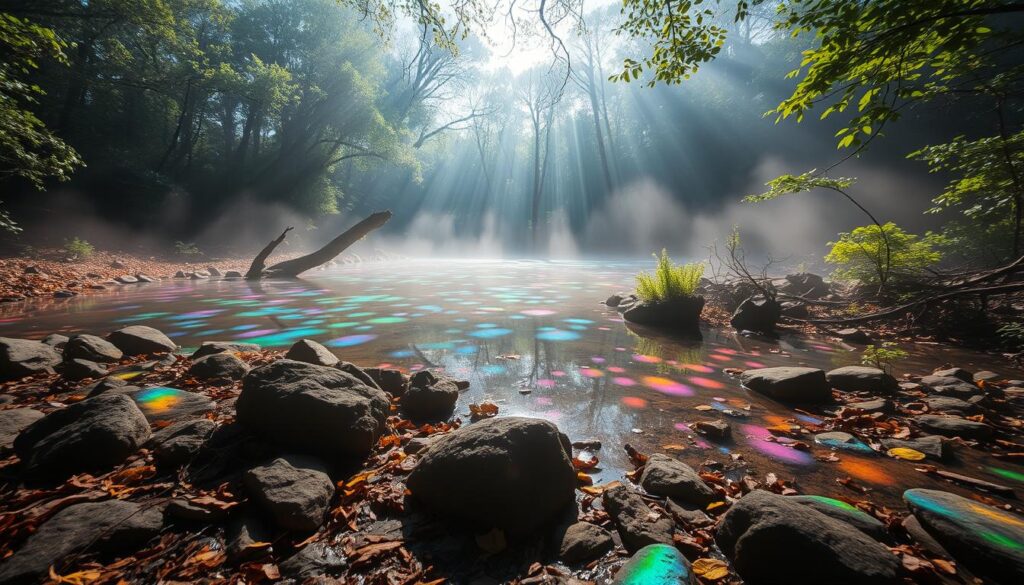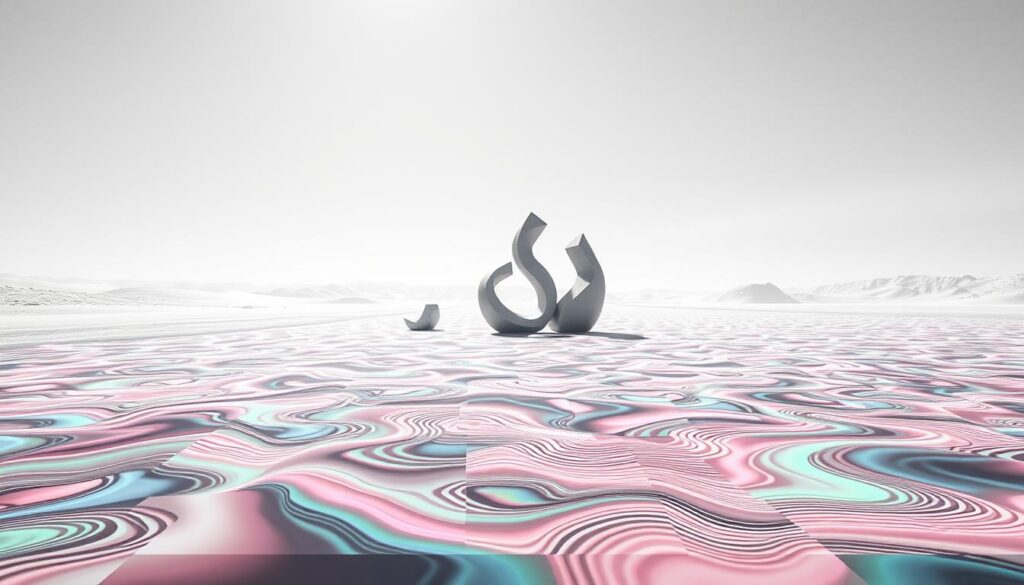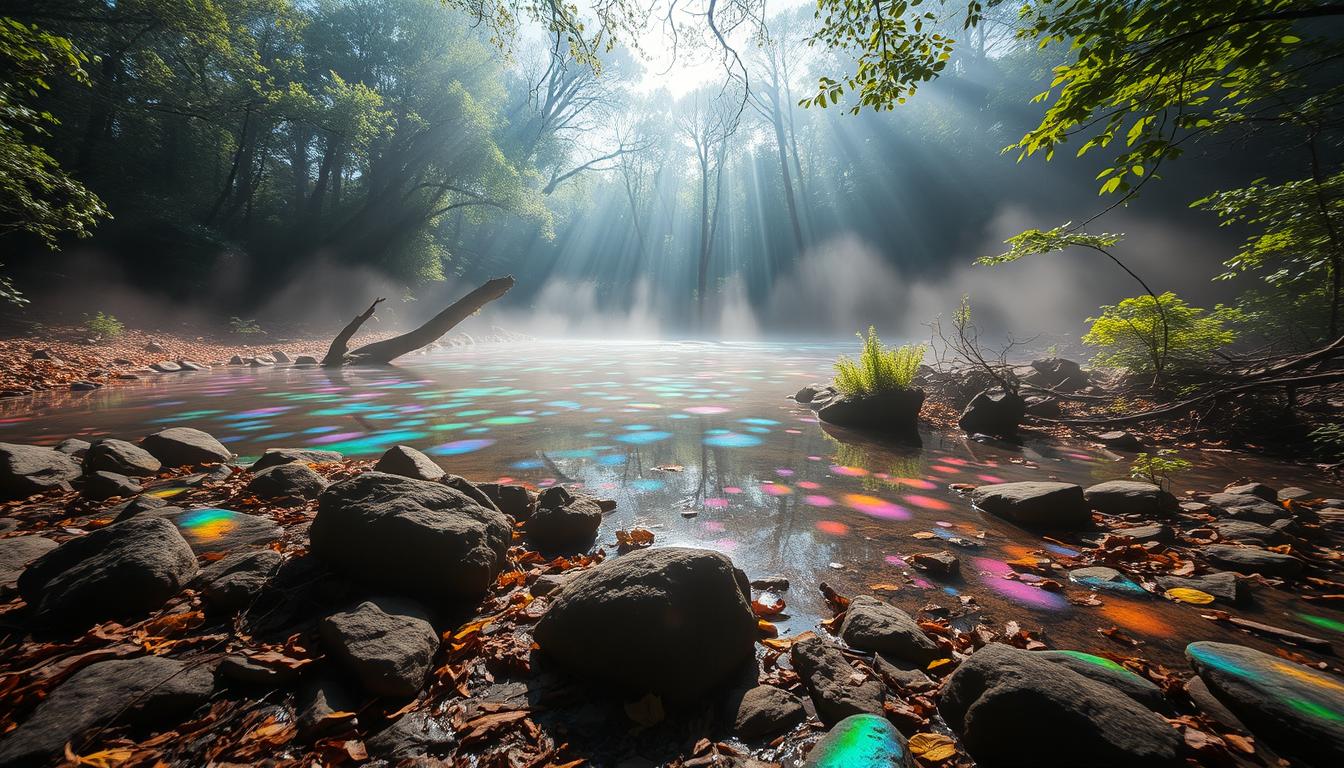Phantom colors are colors we see that don’t really exist. They have always fascinated people who study optical illusions and color perception. Our brains create these colors, even though they’re not there in the real world.

Studying phantom colors is really exciting. It shows us how our brains work when we see colors. By learning about this, we can understand more about art, design, and technology.
Introduction to Phantom Colors
Phantom colors are a kind of optical illusion. They make us question how we see colors. As we explore phantom colors, we’ll see how they affect art, design, and psychology.
Key Takeaways
- Phantom colors are a phenomenon where you see colors that don’t exist
- They are a type of optical illusion that challenges our understanding of color perception
- The study of phantom colors reveals the intricacies of human color perception
- Phantom colors have many interesting implications for fields such as art, design, and psychology
- Understanding phantom colors can help us gain a deeper understanding of human vision and perception
Understanding the Phenomenon Where You See Colors That Don’t Exist
Phantom colors are a fascinating visual phenomena we see every day. They are created by how our brain interprets visual information. This process is complex, involving color perception and the context of what we see.
Our brain uses past experiences and expectations to shape our color perception. For instance, seeing a banana picture makes us think it’s yellow, even if it’s not. This is a brain trick that affects how we see colors. Here are some common examples of phantom colors in our lives:
- Seeing colors in black and white images
- Perceiving colors in certain lighting conditions
- Experiencing color illusions in art and design
These examples show how phantom colors appear in different situations. They highlight the complex nature of visual phenomena and color perception. By understanding these brain tricks, we can learn more about how we perceive the world.
The Science Behind Color Perception
Color perception is a complex process. It involves color theory and the human visual system. In art and design, knowing about color perception is key. It helps in making visually appealing and effective compositions.
The color spectrum ranges from red to violet. It is seen and processed by the human eye and brain in a special way. This is important for artists and designers.
Colors can interact and create the illusion of phantom colors. This is a fascinating area of study in color theory. By understanding color interaction, artists and designers can evoke emotions and convey messages.
Some key principles of color theory include:
- Color harmony: the way colors work together to create a visually appealing effect
- Color contrast: the way colors appear in relation to each other
- Color context: the way colors are perceived in different environments and contexts
In art and design, knowing about color perception and theory is crucial. It helps in creating effective and visually appealing compositions. By using color theory, artists and designers can create works that evoke emotions and engage the viewer.
How Our Eyes Process Color Information
The human eye is amazing, able to see a wide range of colors. At the center of this ability are the cone cells. These cells turn light into electrical signals. The brain then interprets these signals as different colors and shades.
The psychology of color is key in this process. Our brains react to colors in unique ways, often without us realizing it.
New discoveries in technology and color have helped us understand color vision better. For instance, research shows that color vision involves complex neural pathways. This knowledge has led to the creation of advanced technologies like color-calibrated displays.
- The type and intensity of light entering the eye
- The sensitivity of the cone cells to different wavelengths of light
- The complex neural pathways that interpret and process color signals
By understanding these factors, we can appreciate the human visual system’s incredible abilities. We see how psychology of color and technology and color impact our lives every day.
Famous Phantom Color Illusions
Phantom color illusions are a fascinating part of visual phenomena found in art and everyday life. They happen when our brain sees colors that aren’t really there. This creates a unique and intriguing experience.
One famous example is the optical illusion of the dress that seems to change color with the light.
Other examples include the Lilac Chaser illusion, where a lilac dot seems to move in a circle, leaving a trail of phantom colors. The Hermann Grid illusion also shows gray dots surrounded by phantom colors, making a checkerboard effect. These illusions show how our brain can trick us into seeing colors that aren’t there.
Here are a few famous phantom color illusions:
- The Bezold-Brücke effect, where a color appears to change hue when surrounded by a different color
- The Fechner color, where a gray dot appears to have a phantom color when viewed against a colored background
- The Benham’s top, where a spinning top appears to display a range of phantom colors as it rotates
These examples show the power of optical illusions and visual phenomena to change how we see color. They create a fascinating and complex world of phantom colors that inspire and intrigue us.
The Psychology of Color Perception
Color perception is a complex process. It involves our visual system, brain, and cultural background. The psychology of color greatly influences how we see and understand colors. Color theory suggests that different colors can trigger different emotions and reactions.
Cultural influences play a big role in color perception. For instance, white is seen as purity and innocence in Western cultures. But in many Asian cultures, it’s linked to mourning. This shows why it’s crucial to consider cultural differences in color theory and psychology of color when designing or communicating.
Cultural Variations in Color Meaning
- Red is linked to love and passion in Western cultures. But in Chinese culture, it means good luck and prosperity.
- Blue is seen as trust and loyalty in Western cultures. Yet, in many Latin American cultures, it’s associated with sadness and mourning.
Individual Differences in Color Experience
Color vision can vary from person to person. Some have color blindness, while others have tetrachromacy, seeing more colors. This underlines the need to account for individual differences in color theory and psychology of color when designing or communicating.
When Phantom Colors Appear in Nature
Nature shows us amazing colors, from sunset hues to rainbow dazzles. These sights are not just pretty; they show how light and matter play tricks on our brains. The colors we see are often illusions, where our brain makes colors seem real even if they’re not.
Phantom colors can be seen in oil slicks on water, butterfly wings, and the aurora borealis. These wonders show how light and matter interact. They also show how our brains turn these interactions into the colors we see.

By studying these natural color displays, we learn more about how our brains see color. This knowledge helps in art, design, and tech. It lets us create amazing visual effects by playing with light and color.
Here are some key examples of phantom colors in nature:
- Sunsets: The vibrant hues of sunsets are created by the scattering of light by atmospheric particles, which creates the illusion of colors that are not physically present.
- Rainbows: The colors of the rainbow are created by the refraction and dispersion of light as it passes through water droplets in the air.
- Oil slicks: The shimmering effects of oil slicks on water are created by the interference of light as it reflects off the surface of the oil and the water.
Digital Screens and Phantom Colors
New screen technology lets us see phantom colors. This is changing art and design a lot. Digital artists can now make amazing visual effects with software.
These effects include phantom colors. Digital media is now used to create immersive and interactive experiences. These experiences play with our color perception.
Recent tech advancements have made high-definition screens possible. These screens can show a wide range of colors, including phantom ones. This has brought together technology and color in new ways.
Some key features of these screens are:
- High-definition displays
- Wide color gamut
- Advanced color calibration
In digital art and design, phantom colors are used for unique effects. Artists use software to play with color. This creates engaging experiences for users.
The mix of technology and color has opened up new creative paths. It has brought innovation to digital art and design.
The Role of Lighting in Phantom Color Perception
Lighting is key in how we see colors. It can make colors seem more alive or dull. Our eyes adjust to light changes, and colors around us affect what we see.
In the case of phantom colors, lighting can change how we see them. Soft, warm light can make them seem softer. But bright, cool light can make them stand out more. This is crucial in art and design to set the mood.
Important factors in lighting and phantom color perception include:
- Light intensity: Bright lights make phantom colors pop, while dim lights make them fade.
- Light color: Warm lights feel cozy, while cool lights energize.
- Surrounding colors: Colors near phantom colors can change how we see them, making them more or less noticeable.
Artists and designers use this knowledge to control phantom colors. They can create feelings and moods, from calm to lively. This lets them craft unique experiences for viewers.
Artists Who Have Exploited Phantom Colors
Phantom colors have captivated artists and designers, leading to stunning works. These optical illusions have been used in various art forms. They challenge our views and spark our imagination.
Victor Vasarely and Bridget Riley are famous for their use of phantom colors. They employed color, light, and shadow to add depth to their art. Their work shows how phantom colors can transform simple images into complex ones.
Today, artists use phantom colors in new ways. They create digital art that moves and changes. In installation art, phantom colors make us question space and color.

- Creating optical illusions that challenge our perception of reality
- Using color and light to create a sense of movement and energy
- Experimenting with digital media to create interactive installations
- Pushing the boundaries of art and design with innovative uses of phantom colors
Scientific Research and Recent Discoveries
Recent studies on color perception have opened up new insights into visual phenomena. Thanks to technology, researchers can now play with color in creative ways. This has led to new artistic possibilities and a deeper understanding of how we see the world.
Some key findings include using brain-computer interfaces to study color and creating phantom colors in virtual reality. These tools help scientists understand how our brains process colors. They also help in finding new ways to create phantom colors.
- The importance of contextual factors in shaping color perception
- The role of attention and expectation in modulating phantom color experiences
- The potential for technology to enhance or manipulate color perception in various applications
As research keeps moving forward, we’ll see more exciting uses of visual phenomena and color manipulation. This will impact art, design, advertising, and more.
Practical Applications in Modern Design
Learning about color theory and the psychology of color can really help in modern design. Designers use color to make things interesting and memorable. In ads and marketing, phantom colors grab attention, stir feelings, and build brand identity.
In buildings and home design, phantom colors play tricks on the eye. They can make a room look bigger by using light colors and phantom colors. Here are some ways phantom colors are used today:
- Advertising: making ads stand out with phantom colors
- Marketing: using color to make brands memorable and emotional
- Architecture: creating fake depth and space with phantom colors
- Interior Design: adding texture and interest with phantom colors
Designers who know about color theory and psychology of color can make designs that really grab people’s attention. As technology gets better, we’ll see more phantom colors in design. This will let designers do even more amazing things.
Conclusion: The Ongoing Mystery of Our Color Perception
As we wrap up our exploration of phantom colors, it’s clear that color processing in our brains is still a big mystery. The study of how we see colors is both intriguing and constantly changing. It fascinates scientists, artists, and fans of color alike.
In this article, we’ve looked at the science behind optical illusions that make us see colors that aren’t there. We’ve been amazed by how our eyes and brain work together. We’ve also seen how artists have used phantom colors to stir emotions and challenge our views.
Looking ahead, new tech, brain science, and psychology will help us understand phantom colors even better. By studying how our brains work, we might learn even more about color perception.
So, let’s keep exploring the mystery of color perception. We can do this through science, art, and our own experiences. The journey of discovery is just starting, and we’re in for exciting new findings about our amazing minds.
FAQ
What are phantom colors?
Phantom colors are colors that seem to appear to our eyes, even if they’re not really there. They show how our vision works with the world around us.
How do our brains create phantom colors?
Our brains make phantom colors by using what our eyes tell us and making guesses based on what we’ve seen before. This guessing can make us see colors that aren’t really there.
What are some common examples of phantom colors in daily life?
You can see phantom colors in many everyday things. Like the shimmer on oil in water, the bright colors of sunsets, and the shiny look of soap bubbles or butterfly wings.
How does the science of color perception explain phantom colors?
Color perception science looks at how our eyes and brain work together. It shows how we can see colors that aren’t really there in objects or scenes.
What are some famous examples of phantom color illusions?
Many artists and designers have used phantom colors to create amazing visual tricks. Famous examples include Victor Vasarely’s Op-Art, Bridget Riley’s color-changing art, and Android Jones’s digital art.
How do cultural influences and individual differences affect color perception?
Our culture and personal experiences shape how we see colors. Different cultures see colors in different ways, and personal traits like color blindness can change our color experiences.
What role does lighting play in the perception of phantom colors?
Lighting greatly affects how we see colors, including phantom colors. The way light hits surfaces can make us see colors that aren’t really there, like in sunsets and rainbows.
How have artists used phantom colors in their work?
Artists have long been interested in phantom colors. They’ve used them to create stunning art, from Op-Art to digital art that plays with color perception.
What are the latest scientific discoveries and research on phantom colors?
Scientists are still learning about phantom colors. New technologies like brain-computer interfaces and virtual reality are helping us understand more about how our brains see colors.
How are phantom colors used in modern design and practical applications?
Designers use phantom colors in many ways, like in ads, marketing, architecture, and interior design. They use color to grab attention and create lasting impressions.
